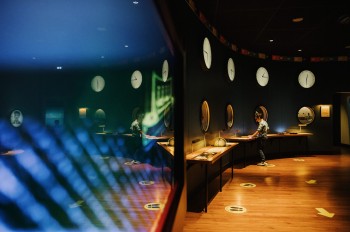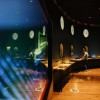Contents
Description

In the north-west of Normandy in France, the deep-sea museum La Cité de la Mer offers an exciting experience for the whole family.
Europe's deepest aquarium
The museum brings visitors closer to the underwater world and exploration of deep seas on the site of Cherbourg's former transatlantic port railway station. The park offers a fascinating underwater world with 17 aquariums representing different ecosystems and housing more than 1,200 fish species. Aside from sharks, rays, jellyfish, seahorses, clownfish, and surgeon fish, there are also rays and jellyfish. Highlights include the Abyssal Aquarium. With a depth of almost eleven metres, it is the deepest aquarium in Europe.
The largest walk-in submarine in the world
Besides the Abyssal Aquarium, the main attraction in the underwater theme park is the submarine "Le Redoutable". Le Redoutable is a nuclear submarine of the French Navy, with space for a crew of 135. It is not only the first nuclear submarine built in the Cherbourg shipyard, but also the largest walk-on submarine in the world. It measures 128 metres, weighs over 9,000 tonnes and can be armed with up to 16 ballistic missiles. "Le Redoutable" was decommissioned in the 1990s and has become a museum ship in Cherbourg.
The Titanic exhibition
"The Titanic, back in Cherbourg" is an interactive exhibition that reveals the secrets of the famous ship and its sinking. The Cité de la Mer underwater museum recently opened a permanent exhibition "Forgotten Objects, Rediscovered Stories" featuring 43 Titanic objects. Among the items on display are the personal effects of Titanic passengers, such as Franz Pulbaum, a 27-year-old German emigrant who boarded the ship at Cherbourg in second class on 10 April 1912.
Virtual underwater expedition
Since 2008, visitors have also taken part in a virtual underwater expedition. A number of tests are conducted in various rooms before the group descends into a virtual submarine. Meanwhile, the realistic underwater world of the deep sea is simulated in a large window.
Exhibition and media library
There is also an exhibition area with diving devices and equipment used in deep-sea expeditions. On display, for example, is the submersible Archimède, which reached a depth of 9,545 metres in the Kuril Trench. In addition, a media library with books, magazines and DVDs is available for visitors. These contain documentaries about the deep sea and individual diving expeditions.
Historical Information

The museum was inaugurated on 29 April 2002. The Cherbourg transatlantic port railway station was a significant railway station in Cherbourg, France. It played a key role in passenger and freight traffic between Europe and America in the late 19th and early 20th centuries. Built in 1858, it was the base for rapid passenger and goods transport between Paris and Cherbourg, where passengers could transfer to ships bound for America.
Before the First World War, Cherbourg was a major departure point for passengers on luxury linerssuch as the Titanic. The station remained operational until the 1930s. Over time, the port of Cherbourg lost its importance due to the increasing use of planes in transatlantic traffic. Today, the station is no longer in use, but is a listed building and serves as a museum.
How to get there
La Cité de la Mer Museum can be easily reached both by car and by public transport.
By car: Cherbourg can be reached via the A13 motorway from Paris and via the A84 from Caen. There is paid parking near the museum. There are plenty of signposts to get there.
By public transport: Cherbourg train station is served by trains from Paris, Rennes, Caen and other Normandy towns. From the station you can take a bus or taxi to the Cité de la Mer.







